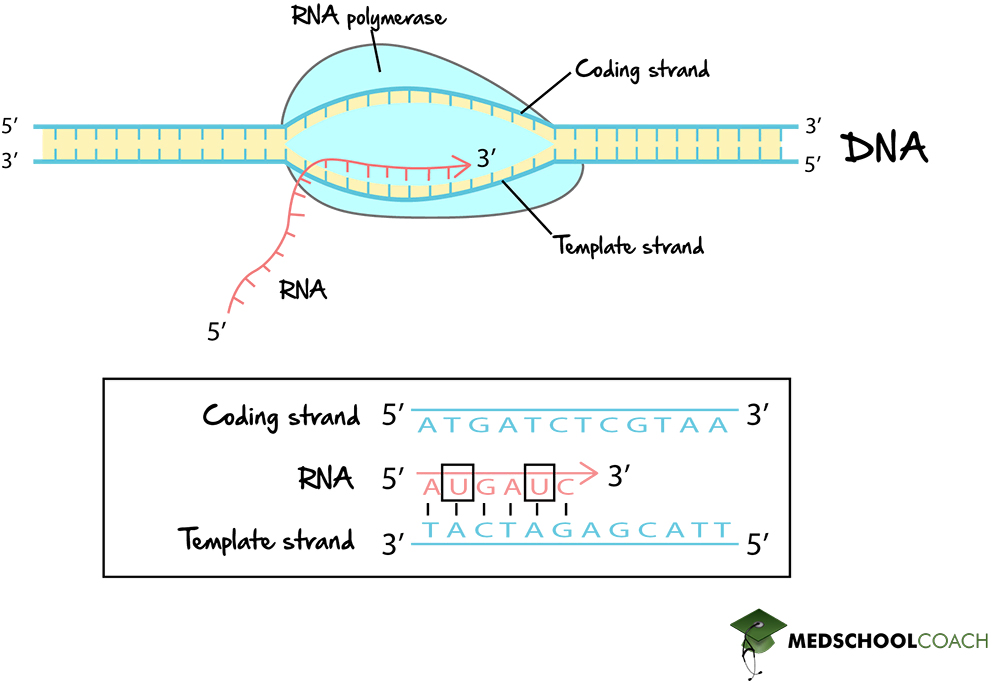Mechanism of Transcription
MCAT Biology - Chapter 2 - Section 1.2 - Gene Expression - Mechanism of Transcription
- Home
- »
- MCAT Masterclass
- »
- Biological and Biochemical Foundations of Living Systems
- »
- Biology
- »
- Mechanism of Transcription – MCAT Biology
Sample MCAT Question - Mechanism of Transcription
RNA transcripts are complementary to which strand of DNA?
a) The coding strand
b) The complementary strand
c) The protein strand
d) The template strand
D is correct. The template strand.
During transcription, DNA gets unwound by RNA polymerase to form a template strand and a coding strand. RNA polymerase binds to the template strand and, using nucleotides, creates a complementary RNA sequence. Therefore, RNA is complementary to the template strand and has the same sequence as the coding strand with uracil in place of thymine.
Get 1-on-1 MCAT Tutoring From a Specialist
With MCAT tutoring from MedSchoolCoach, we are committed to help you prepare, excel, and optimize your ideal score on the MCAT exam.
For each student we work with, we learn about their learning style, content knowledge, and goals. We match them with the most suitable tutor and conduct online sessions that make them feel as if they are in the classroom. Each session is recorded, plus with access to whiteboard notes. We focus on high-yield topics if you’re pressed for time. If you have more time or high-score goals, we meticulously cover the entire MCAT syllabus.
Transcription Intro
Transcription is the biological synthesis of RNA using DNA as a template. Central to this process is the enzyme RNA polymerase, which performs all of the functions of transcription. DNA replication, by contrast, involves several enzymes. So transcription is, in fact, a much more straightforward process than DNA replication.
Step 1: RNA Polymerase Binds the Promoter
Transcription begins when RNA polymerase binds to the promoter. The promoter is a specific sequence of DNA that can be thought of as the transcription start site. In order for DNA to be transcribed into RNA and in order to express a particular gene, RNA polymerase must first bind to the promoter region of that gene.
Step 2: RNA Polymerase Unwinds the DNA
Once RNA polymerase binds to the promoter region on DNA, it will begin to unwind the DNA. This process occurs because RNA polymerase will use DNA as a template to create RNA. So, in addition to having polymerase activity, RNA polymerase has helicase activity as well. The primary function of helicase enzymes is to unpack, unwind, or unzip genetic material. Once DNA is unwound, two separate strands will be formed. One strand of DNA is called the template strand, and the other strand is called the coding strand.
Step 3: Complementary RNA Synthesis
Once the DNA strands are separated, RNA polymerase binds to the template strand and, using it, creates a new RNA sequence, as shown in Figure 1 below. This new RNA sequence is complementary to the template DNA strand and has the same sequence as the coding strand, except that RNA contains the nucleotide uracil in the place of DNA’s thymine.

Step 4: End of Transcription
RNA polymerase will continue to synthesize the new RNA transcript until it reaches a transcription stop site. At this point, it will stop transcribing the DNA. So unlike DNA replication, where the entire chromosome/genome gets replicated, transcription only reproduces a fraction of the genetic information found on the relevant chromosome. And which part gets transcribed depends on the needs of the cell and its regulatory mechanisms.
Proofreading During Transcription
As a final point, note that RNA polymerase, unlike DNA polymerase, does not have proofreading activity. This means that not every RNA transcript will perfectly match its DNA coding strand counterpart. If an erroneous RNA transcript is then translated, the resulting protein product may be non-functional, depending on the significance of the errors.
The reason RNA polymerase does not have proofreading activity is not fully understood, but one reason may be because RNA is not as stable as DNA. After RNA is made, it can be degraded relatively quickly. However, DNA is meant to stick around for the entire duration of an organism’s lifespan. Since this is the case, DNA must remain error-free. However, if a mistake is made when transcribing RNA, it may not have as severe an effect because of its short lifespan. After it is degraded, a brand-new, error-free RNA molecule can be created.
Explore More MCAT Masterclass Chapters
Take a closer look at our entire MCAT Masterclass or explore our Biochemistry lessons below.

One-on-One Tutoring
Are you ready to take your MCAT performance to a whole new level? Work with our 99th-percentile MCAT tutors to boost your score by 12 points or more!
See if MCAT Tutoring can help me
Talk to our enrollment team about MCAT Tutoring

MCAT Go Audio Course
Engaging audio learning to take your MCAT learning on the go, any time, any where. You'll be on the way to a higher MCAT score no matter where you are. Listen to over 200+ lessons.

MCAT Practice Exams
Practice makes perfect! Our mock exams coupled with thorough explanations and in-depth analytics help students understand exactly where they stand.

MCAT Prep App
Access hundreds of MCAT videos to help you study and raise your exam score. Augment your learning with expert-created flashcards and a question banks.